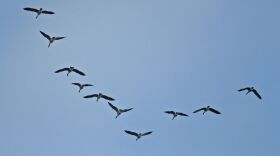Imagine using a trained bird to do your fishing instead of a fishing pole. The Masked Biologist considers an ancient practice, cormorant fishing, in this week’s Wildlife Matters.
I was looking back over some old notes to help me come up with an idea for this week’s Wildlife Matters and I saw fishing with cormorants way down near the bottom. This was a note I had written to myself after a reader or listener had told me that they had once seen a tourist attraction, maybe a circus act, where someone used a trained cormorant to catch fish. I decided I should look it up in the future and learn more about this concept.
We have cormorants here in Wisconsin, actually, a very common North American species called the double crested cormorant. At one time their persistence was in doubt, due to a combination of overshooting and lethal pesticides like DDT in the middle of the last century. After DDT was banned and the birds were protected, their numbers rebounded. Now they have increased in number to the point where their overabundance is problematic in some areas. Cormorants are piscivorous, which means they eat fish. These birds are skilled divers and have no trouble catching fish underwater. So, when someone told me they had been trained to catch fish, it seemed like a reasonable concept.
The Japanese practice of Ukai, or using birds to catch fish, has been around for a very long time, possibly originating in Japan in the six or seventh century AD. According to Wikipedia, it was practiced in Japan, China, Korea, and even Greece, Macedonia, and briefly in England and France. As with many ancient traditional practices, Ukai has become somewhat of a tourist attraction, a novel curiosity carried on mostly for the sake of the tradition itself, making the city of Gifu in central Japan a destination. The practice is straightforward; young wild birds are captured and taught how to fish by watching and learning from older birds. They use flaming torches over the water to attract the prey, a small fish resembling our trout. The fishing bird is tethered for recapture, and there is a ring or loop placed around their neck. These birds swallow fish whole, head-first, so the loop prevents them from swallowing larger fish. They can eat smaller fish, but when they surface with a larger fish in their gullet, the fishermen grab them and remove the fish. There are some who question whether this practice is humane, and understandably so—grabbing a bird by the neck and pulling food out of their mouth does not seem like a practice we would use today. The practice is fascinating nonetheless, and it has garnered a lot of attention from travelers across the globe.
Learning about this practice got me wondering if other species have been trained to “cough up” their fish. I found out that otters have also been used to catch fish in parts of Asia, Northern Africa, Scandinavia and the British Isles. Today, the only information I could find about active otter fishing practices comes from Bangladesh. Here again, this is a practice seemingly carried on as a glimpse into a bygone era for the sake of history and tourism. Otter fishing is a bit different from cormorant fishing. From what I can find, no one tries to wrestle away fish from otters. Instead, the otters are used to round up the fish, or roust them out of their hiding places and either into a net or out into the open where they can be scooped up.
Before we start affixing modern labels to these ancient practices, or decide to sit in judgement of those who have developed and employed them, I would point out that the United States is pretty rare among nations in that we have developed a healthy sport fishery across the country. In many other areas around the globe, fish form a cheap and healthy source of protein for those who live well below what we would consider the poverty line. To work to train wild animals to help one get food to eat or sell would probably be no different than training a horse to pull a plow, or a dog to help with the hunt. If I have a bad day of fishing, it is still a day out on the water, with my boat, having fun with family or friends. For others through the centuries, a good day’s fishing may have meant going to bed with a full belly.
Striving to make new things familiar and familiar things new, this is the Masked Biologist coming to you from the heart of Wisconsin’s great Northwoods.
The above photo belongs to Flickr user Shahin Abasov and can be found online here.







